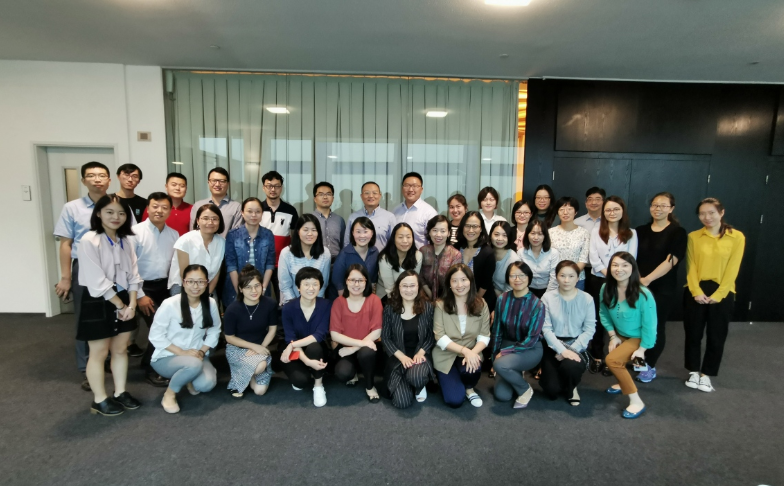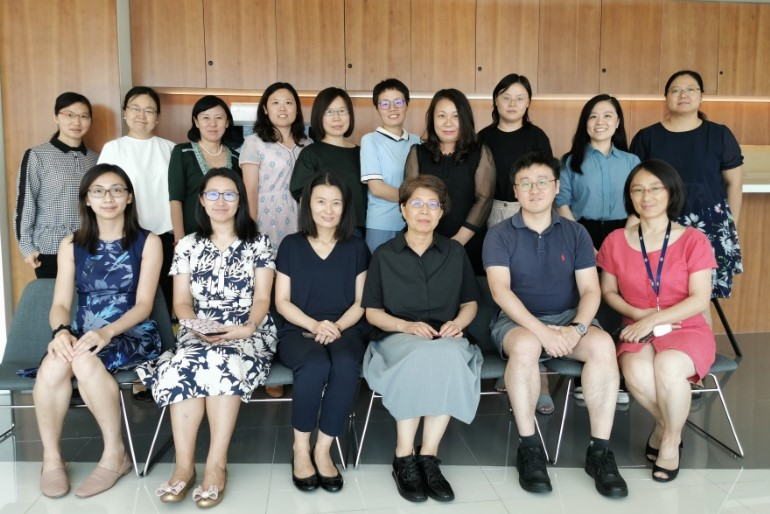The 3rd CQAF 2019 Quarterly Meeting was held in the afternoon of Sep. 2nd in the Roche Beijing and Shanghai office. A total of 103 members from around 70 pharmaceutical companies, clinical trial institutions and contract research organizations participated in the face-to-face meeting or WebEx meeting. The conference was hosted by Dr. Yifeng Shen and focused on recent hot topics in quality management: including Central Lab/ BioA Lab workflow overview and PV sub-committee update & system introduction.
CQAF 2019年第三季度会议于9月2日下午在罗氏北京和上海办公室举行。来自约70家制药公司、临床试验机构和合同研究机构的103名成员参加了面对面会议或WebEx会议。本次会议由沈一峰博士主持,重点讨论了质量管理领域的最新热点问题:包括中心实验室/生物实验室工作流程概述和药物警戒体系的介绍和药物警戒分会的更新。

CQAF 2019 Q3 Meeting, Shanghai

CQAF 2019 Q3 Meeting, Beijing
1. Central Lab/BioA Lab workflow overview: How to ensure the data accuracy and integrity
Presentation by Jiajia Zhu and Xuehua Cheng, GCLP Sub-Committee (CLQA)
At this Quarterly Meeting, Jiajia and Xuehua, the leaders of the CLQA ( the sub-committee of CQAF), shared how the Central laboratory and Bioanalytical laboratory can ensure the accuracy and intigrity of the data generation by data analysis in clinical trial. The two speakers also introduced the data flow and sample flow in both labs, the relevant regulations, certification and accrediation, and the relevant guidelines. They also emphasis on how to control the quality of samples and key nodes in the data life cycle to ensure the accurate and intigrated data are provided by the labs to the clinical studies.
CLQA作为CQAF的Subcommittee,在本次季度会上为大家分享了中心实验室和生物分析实验室如何确保临床试验样本分析产生数据的准确与完整性。两位讲者为大家分别介绍了中心实验室和生物分析实验室的样本流及数据流,相关法规要求、认证认可以及遵守的相关指南,更着重剖析了如何通过样本与数据生命周期各关键节点的质量把控,来保证实验室为临床提供的数据的完整与准确。
For both central and bioanalytical laboratories, the sample flow and data flow are initiated from the investigator site, accurate and efficient guidance shall be provided to make sure that site collects samples correctly and fills out information correctly, which are the key elements at this stage; Prior to sample analysis, the temperature control of the sample during transportation, appropriate storage of the sample and accurately transfer of the information are the key elements; During sample analysis, the instrument, reagents, methods, personnel and environment are the key elements; after the sample analysis, the data transfer and correctly and timely report distribution are critical elements. These key factors in sample and data whole lifecycle are monitored and controlled by lab to ensure the accuracy and integrity of the data.
对于中心实验室和生物分析实验室而言,样本和数据的生命周期始于研究中心,实验室为研究中心提供关于样本采集和信息填写的指导是关键;样本离开研究中心并且在在分析前,样本的运输温度的控制、正确储存以及信息正确传递是关键;样本分析中,仪器、试剂、方法、人员和环境的控制是关键;样品分析后,数据的传输和报告的准确及时发送是关键。实验室通过对样本和数据生命全周期中这些关键因素的控制,来确保数据的准确性和完整性。
After the lecture, questions that were encountered during center laboratory and bioanalytical laboratory audit were discussed, including the certification difference between the central laboratory and the bioanalytical laboratory, if cross validation is needed when different instrument were used during method validation and sample analysis, and the difference between the new FDA method validation guidelines and the old version.
分享结束后,大家就目前在检查中心实验室和生物分析实验室中遇到的问题进行了热烈的讨论,其中包含中心实验室和生物分析实验室的认证区别,生物分析实验室中使用不同的仪器是否需要交叉验证以及新版FDA方法验证指导原则与老版本的区别等。
2. PV sub-committee update & PV system introduction
Presentation by Winnie Wu , PV Sub-Committee
AE/SAE Causality assessment classifications
There are many kinds of classification methods for judging the causality of adverse events/serious adverse events in clinical research: most of the clinical research investigational sites follow the guidance of domestic laws and regulations and report to drug regulatory agencies according to the five-score method of "affirmative relevance, possible relevance, possible irrelevance, affirmative irrelevance and impossibility of judgment". This classification is consistent with that of WHO-UMC. the Sponsor will follow different regulations, guidelines or company requirements, including the seven-score method, the four-score method or the two-score method. According to the principles of the structure and content of <ICH E3 Structure and Content of Clinical Study reports> and <ICH E2F Development Safety Update Report (DSUR)>, although causality assessment is usually helpful for the evaluation of rare adverse drug reactions (ADRs) and decision-making on rapid reporting, its value in the individual case reports is of low in comprehensive data analysis under the condition of group comparison. Safety analysis focused on each adverse event, and the number of patients and the rate in each adverse event in each treatment group. Therefore, exploring the necessity of multiple taxonomies and corresponding principles in different taxonomies is a major demand of the industry at present.
临床研究中对不良事件/严重不良事件的因果关系判断存在多种分类方法:临床研究中心大多遵从国内的法规指导按“肯定有关、可能有关、可能无关、肯定无关和无法判断”五分法向药监机构进行报告,该分类和WHO-UMC的分类比较一致;申办方则会遵循不同的法规、指南或公司要求,包括七分法、四分法或两分法等做法。而根据《ICH E3 临床研究报告的结构和内容》 及《ICH E2F研发期间安全性更新报告》 的原则,虽然因果关系评估通常有助于个别罕见药物不良反应(ADR)的评价,以及关于快速报告的决策,但在可以组群对比的条件下,个例报告中的因果关系评估在综合数据分析中的价值较低。对每例不良事件、各治疗组中发生事件的患者数目以及发生率是研究中安全性分析的重点。因此探索多种分类法的必要性和在不同分类法的对应原则是目前行业的一大需求。
Pharmacovigilance system introduction
Pharmacovigilance is a scientific and related activity to detect, evaluate, understand and prevent adverse reactions or any other possible drug-related issues, throughout the life cycle of products. Establishing a comprehensive and effective pharmacovigilance system is not only for fulfilling legal responsibilities, but also an important system for drug holders to monitor and establish drug benefit-risk balance.
An integrated pharmacovigilance system includes: the person in charge of pharmacovigilance, organizational framework, drug safety data sources, computer systems and databases, business-related processes, system performance and quality system to ensure the smooth reception of safety information from different sources, timely input of drug safety database, medical assessment and validation, identification and extraction of risk signals, generation of drug benefit-risk balance reports and risk management plans, the regulatory documents including drug instructions, timely disclosure of drug safety characteristics to regulatory bodies, prescribers and drug users, to ensure the safety of medication for the majority of drug users.
药物警戒是检测、评估、理解和预防不良反应或其他任何可能与药物有关问题的科学及相关活动,贯穿于产品的生命周期。建立全面而有效的药物警戒系统不仅为了履行法律职责,更是药物持有人监测和建立药物获益-风险平衡的重要体系。
一个完整的药物警戒系统包括:药物警戒负责人、组织构架、药物安全数据来源、计算机系统和数据库、业务相关流程、系统性能及其质量体系等内容,以确保顺利接收不同来源的安全性信息,及时输入药物安全数据库,进行医学评估和验证、识别和提取风险信号,产生药物获益-风险平衡报告及其风险管理计划,并生成包括药品说明书在内的法规性文件、及时向监管机构、处方人和用药人披露药物的安全特性,确保广大用药人的用药安全。
———————————————————————————————————————————————
Upcoming CQAF Events
DIA–CQAF Corrective Action and Preventive Action Workshop (CAPA), Nov. 4-6, 2019, Courtyard Marriot Shanghai Pudong
The workshop is designed to help participants learn what regulators expect in CAPA management through a teach-do-teach-do approach. Good and poor examples will be presented along the way to support participants perform comprehensive investigations with robust CAPAs that can be applied practically in day to day work.
本研讨会旨在帮助参与者通过“教-做-教-做”的方法了解监管者对CAPA管理的期望。研讨会上将借助一些成功的和糟糕的案例,来帮助参与者学习可用于在日常工作中的全面调查研究的CAPA方法。
DIA–CQAF cQMS Workshop, Dec. 13-14, 2019
This workshop aims to address the growing business needs relating to the development /enhancement of clinical Quality Management System (cQMS) within R&D based pharmaceutical companies/CROs.
Topics include but not limited to the key elements of cQMS, the application of cQMS methodology to enable the effective execution of clinical projects, the adequate assessment of cQMS.
本次研讨会旨在解决研发型制药公司/合同研究组织中与临床质量管理体系(cQMS)开发/改进相关的日益增长的业务需求。主题包括但不限于cQMS的关键要素、应用cQMS方法以使临床项目得以有效执行,以及对cQMS的充分评估。
For slides of each topic and Video for GCLP topic, please click the page 2 at bottom of this page.
关于上述的分享PPT,请登陆会员账户,点击下方第二页。
For how to register for CQAF member, please refer to CQAF Website User Guide
关于如何注册和登陆会员账户,请参见 CQAF Website User Guide

 沪公网安备 31011202013414号
沪公网安备 31011202013414号